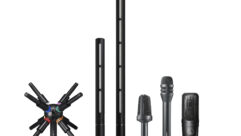
Audio Review: AKG D7
May 6, 2009 12:00 PM,
By John McJunkin
A handheld mic that makes good on its reference-quality claim.

There has been a flood of new studio mics of varying designs over recent years, but it seems as though handheld vocal microphones have been left behind by comparison. The truth is that although there haven’t been dozens of new handheld vocal mics recently, there are a number of manufacturers who have raised the bar in this domain, and AKG is among them. I have had exposure to AKG’s D5 and C5 handheld mics in the past couple of years, and I was duly impressed, so I was excited to get a look at the D7—AKG’s latest offering in handheld mics.
The D7, like other AKG mics, exhibits an attractive appearance. It’s 7.3in. in length and 2in. in diameter at its widest point, which is the metal ring around the mic’s beefy spring-steel wire mesh. The mic’s zinc-alloy die-cast body tapers steeply to the segment of the body that’s intended for handling, which tapers less drastically down to the tail end of the mic, where its balanced XLR connector is found, surrounded by a bevel in the mic body. The D7’s matte-finish metal handgrip surface is a source of minor concern for me; a nice rubberized surface would lend a much better grip. I’ve stated this about the mics of numerous manufacturers, so I want to be clear that I’m not poking at AKG exclusively. It seems to me that even in the case of extremely rugged handheld microphones, dropping them should be avoided at all costs, and a rubberized coating goes a long way toward keeping such mics where they belong—in the performer’s hand.
Two different versions of the D7 are available: the standard D7, which sports a matte gray-blue finish, and the D7 LTD, which features a bright chrome-plated case to “satisfy special aesthetic requirements” as AKG’s documentation states. Although I did not evaluate the latter version, the images of it that are available on AKG’s website make it abundantly clear that it does indeed satisfy those requirements—it’s a beautiful mic. In addition to these two variations of the D7, a D7 capsule is available for use with AKG’s WMS 4000 and WMS 4500 wireless systems.
AKG’s documentation touts several desirable characteristics, and I set out to confirm them—something I normally do when I evaluate products. The main declarations the company makes about this microphone are that it exhibits reference quality, exceptionally high gain before feedback as a result of a frequency-independent supercardioid polar pattern, improved vocal intelligibility resulting from a built-in high-pass filter, minimized electrical interference resulting from a humbucking coil, consistent performance from AKG’s Laminate Varimotion diaphragm, ultralow p-pops resulting from a new inner windscreen, and a reduction of handling and cable noise resulting from a mechanical-pneumatic transducer shock mount.
I addressed the first of these characteristics—that the microphone exhibits reference quality—from a subjective standpoint, comparing the mic with similar mics from other manufacturers. Indeed, the resolution of higher frequencies is truly excellent, delivering a clean, intelligible signal. The published frequency range is 70Hz to 20kHz, with an 80Hz high-pass filter to tame wind noise and help keep plosives under control. The published frequency-versus-sensitivity graph is generally quite flat, with broad 1dB bumps centered around 250Hz and 1.8kHz, and a 2.5dB bump at about 9kHz. There is a slightly narrower bump of about 2.5dB at 5kHz as well. The increased sensitivity at 1.8kHz and 5kHz increases intelligibility, but not in an exaggerated way. I find that with many mics, I cut highs to avoid a fatiguing listening experience or even to avoid feedback in the mains in certain applications. This mic does not require that kind of equalization, and it provides a high degree of intelligibility. The broad boost centered around 250Hz lends a nice warmth to the sound of the mic. Overall, I agree with AKG’s claim that this is a reference-quality mic.
1
Audio Review: AKG D7
May 6, 2009 12:00 PM,
By John McJunkin
A handheld mic that makes good on its reference-quality claim.
AKG’s second claim is that the mic exhibits exceptionally high gain before feedback because of its frequency-independent supercardioid pattern. That AKG managed a supercardioid pattern is not magical; this is not difficult. The impressive feat is to maintain a consistent frequency curve throughout the entirety of the pickup pattern, and AKG truly does accomplish this. Again, in subjective listening tests, I found that within the supercardioid pattern, the frequency curve was indeed remarkably consistent. To be sure, this supercardioid is quite tight by design, but I was impressed with the consistency around the various angles of approach. I was able to achieve some pretty substantial gain before feedback, even with the mic quite close to the monitor loudspeaker. The polar pattern is not so tight as to be performer-unfriendly, and it truly helps to reject feedback.
Related Links

Audio Review: Soundcraft FX16ii
It seems like every time you turn around, there’s another small-format digital mixer. I don’t mean to sound disdainful. I’m a digital mixer owner myself,…

Technology Showcase: Boundary Microphones
In the late ’70s, experiments in sound recording showed that within a few millimeters of a hard, flat surface, sound waves coming from different locations are in-phase due to the near stop of air molecules in the area near the surface…

AKG Acoustics recently released the wireless WMS 4500 microphone system, which offers improved audio capabilities versatile enough to handle multiple users and multichannel applications simultaneously…
I’ll address AKG’s claims of improved intelligibility from the mic’s 80Hz high-pass filter and ultralow p-pops from an inner windscreen. Indeed, the 80Hz high-pass filter focuses the microphone’s output in the range of frequencies important to transducing the human voice. If you have a contrabass, you might choose a different mic, but AKG intends this mic for the vast majority of speakers and singers, and they simply don’t produce any important energy below 80Hz. As to the reduction of p-pops by the mic’s internal foam windscreen, it’s as good as can be expected in a supercardioid dynamic mic of this type, which will inherently exaggerate plosives. This is no small feat, and I’m impressed that this mic nearly eliminates major thumps and bumps without additional suppression of low frequencies via equalization.
As to minimized electrical interference due to the humbucking coil, I simply heard no hum or other RF noise whatsoever, and this mic is quiet in terms of self-noise as well. AKG’s Laminate Varimotion diaphragm, to which I’ve had a bit of previous exposure, does indeed provide consistent performance. Finally, the pneumatic-mechanical interior shock mount that isolates the microphone element is effective and nearly eliminates handling and cable noise. A handheld microphone must reject handling noise, and AKG clearly considered this and acted accordingly.
The bottom line is I really like the clarity and resolution of this mic, and I’m also impressed with the warmth and fullness it exhibits. The AKG D7 is a top-shelf handheld microphone, and I can strongly recommend it for applications that require a superior mic.
John McJunkin is the principal of Avalon Podcasting in Chandler, Ariz. He has consulted in the development of studios and installations, and he provides high-quality podcast-production services.
PRODUCT SUMMARY
- Company: AKG
www.akg.com - Product: D7
- Pros: Consistent frequency response throughout polar pattern.
- Cons: Metal surface a bit slippery for handling.
- Applications: Spoken or singing vocals requiring a handheld mic.
- Price: $239 (D7); $259 (D7 LTD)
SPECIFICATIONS
- Polar pattern: Supercardioid
- Frequency range: 70Hz-20kHz
- Sensitivity: 2.6mV/Pa (-52dBV)
- Maximum SPL: 147dB/156dB (1%/3% THD)
- Equivalent noise level: 18dBA (IEC 60268-4)
- Signal-to-noise ratio: 76dB (A-weighted)
- Impedance: ≤600Ω
- Recommended load impedance: ≥2000Ω
- High-pass filter: 80Hz, always active
- Connector: 3-pin XLR
- Dimensions: 7.3″x2″ (LxD)
- Weight: 12oz.
- Special features: Integrated humbucking coil
2









